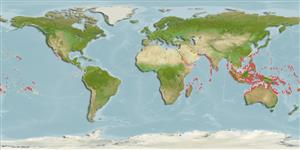Environment: milieu / climate zone / depth range / distribution range
Ecología
marino asociado a arrecife; rango de profundidad 2 - 20 m (Ref. 90102). Tropical; 30°N - 24°S
Indo-Pacific: Red Sea and East Africa (Ref. 33390) to the Hawaiian, Marquesan, and Tuamoto islands, north to the Ryukyu Islands, south to the Great Barrier Reef.
Tamaño / Peso / Age
Maturity: Lm ? range ? - ? cm
Max length : 72.3 cm TL macho / no sexado; (Ref. 90102)
Espinas dorsales (total): 0; Radios blandos dorsales (total): 0; Espinas anales 0; Radios blandos anales: 0; Vértebra: 132 - 137. Body grey with fine pale barring (Ref. 48635). Young with 25-30 dark brown bars separated by white narrow interspaces; bars become obscure with age where in large adults, the pattern becomes mottled brown; corner of mouth dark brown. Head usually lighter, yellowish with variable dark blotching (Ref. 48635).
Inhabits reef flats, clear shallow lagoons, and seaward reefs (Ref. 9710). Benthic (Ref. 58302). Feeds mainly on small crustaceans during both day and night (Ref. 9710).
Life cycle and mating behavior
Madurez | Reproducción | Puesta | Huevos | Fecundidad | Larva
Chen, H.-M., K.-T. Shao and C.T. Chen, 1994. A review of the muraenid eels (Family Muraenidae) from Taiwan with descriptions of twelve new records. Zool. Stud. 33(1):44-64. (Ref. 6934)
IUCN Red List Status (Ref. 130435)
Threat to humans
Harmless
Human uses
Pesquerías: pesquerías de subsistencia; Acuario: Comercial
Más información
Nombres comunesSinónimosMetabolismoDespredadoresEcotoxicologíaReproducciónMadurezPuestaAgregación para la puestaFecundidadHuevosEgg development
ReferenciasAcuiculturaPerfil de acuiculturaRazasGenéticaElectrophoresesheritabilidadEnfermedadesProcesamientoNutrientsMass conversion
ColaboradoresImágenesStamps, Coins Misc.SonidosCiguateraVelocidadTipo de nataciónSuperficie branquialOtolitosCerebrosVisión
Herramientas
Special reports
Download XML
Fuentes de Internet
Estimates based on models
Preferred temperature (Ref.
123201): 25.2 - 29.3, mean 28.4 °C (based on 2833 cells).
Phylogenetic diversity index (Ref.
82804): PD
50 = 0.5005 [Uniqueness, from 0.5 = low to 2.0 = high].
Bayesian length-weight: a=0.00050 (0.00033 - 0.00077), b=3.31 (3.19 - 3.43), in cm total length, based on LWR estimates for this species & (Sub)family-body (Ref.
93245).
Nivel trófico (Ref.
69278): 3.5 ±0.4 se; based on diet studies.
Resiliencia (Ref.
120179): Medio, población duplicada en un tiempo mínimo de 1.4-4.4 años (Preliminary K or Fecundity.).
Fishing Vulnerability (Ref.
59153): Moderate to high vulnerability (49 of 100).
Nutrients (Ref.
124155): Calcium = 37.3 [20.3, 61.5] mg/100g; Iron = 0.477 [0.288, 0.961] mg/100g; Protein = 18.6 [16.4, 21.2] %; Omega3 = 0.0945 [, ] g/100g; Selenium = 35.2 [19.9, 70.5] μg/100g; VitaminA = 65.2 [18.1, 200.0] μg/100g; Zinc = 1.08 [0.77, 1.49] mg/100g (wet weight);
